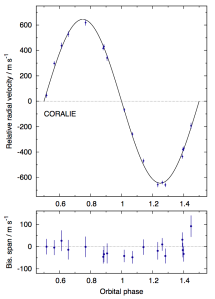Thomas Beatty et al have an interesting new paper on arXiv today, primarily about the transiting brown dwarf KELT-1b. They’ve used the Spitzer Space Telescope to record the infra-red light as it varies around the 1.3-day orbit.
They end up with the following plots (KELT-1b is on the right, with the plot for the planet WASP-43b on the left):

The x-axis is “colour”, the difference in flux between two infra-red passbands at 3.6 and 4.5 microns. The y-axis is brightness (in the 3.6 micron band). The underlying orange and red squares show where typical M-dwarf stars and L and T brown dwarfs fall on the plot.
The solid-line “loops” are then the change in position of the atmospheres of KELT-1b and WASP-43b around their orbits. At some phases we see their “day” side, heated by the flux of their star, and at others we see their cooler “night” side.
The blue line is the track where something would lie if there were no clouds in its atmosphere. The fact that KELT-1b’s loop doesn’t follow the blue track, but moves significantly right (to cooler colours) implies that the night side of the brown dwarf must be cloudy. The night side of WASP-43b, however, appears to be less cloudy, according to its track.
Here are the same plots for two more planets:

The plot for WASP-19b shows a loop with a marked excursion to the right, suggesting a cloudy night side to the planet. For WASP-18b, however, the loop follows a trajectory nearer the blue “no cloud” track, suggesting a clearer atmosphere.






